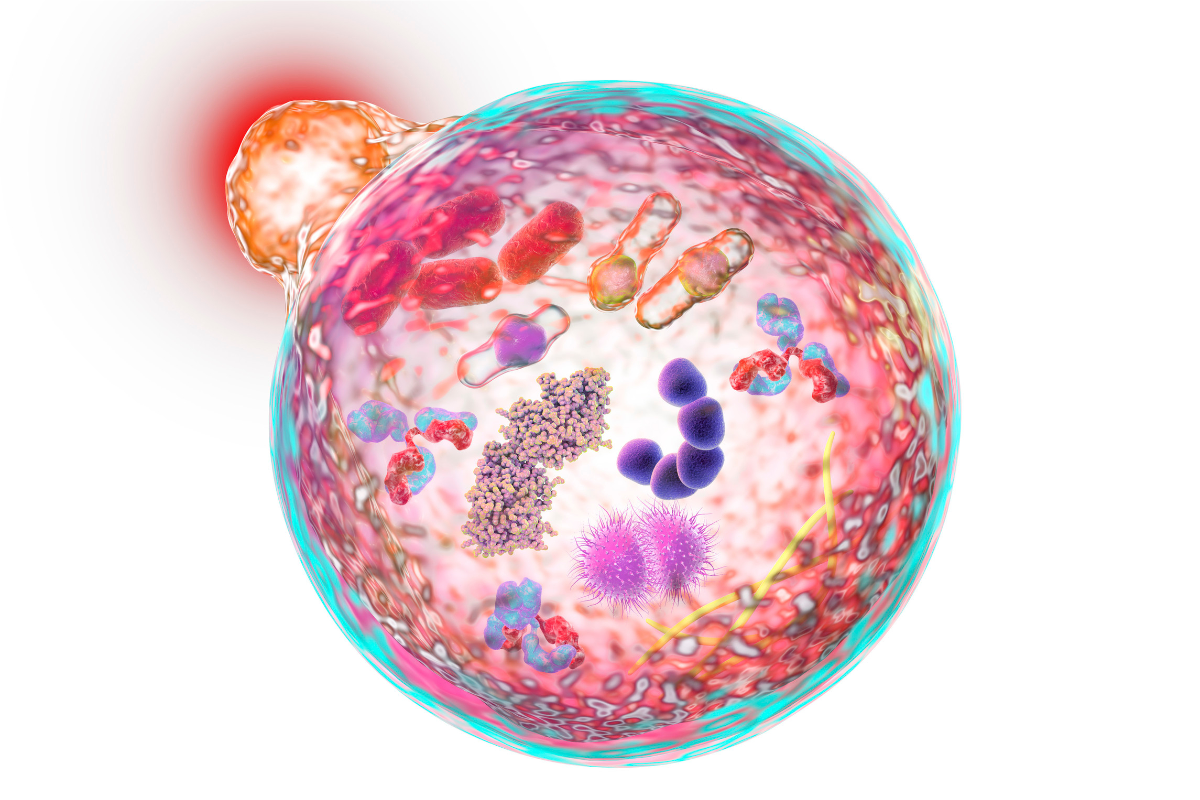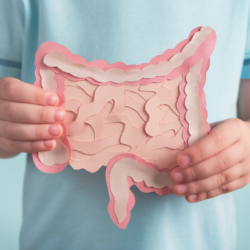Autophagy, a term derived from the Greek meaning “to eat oneself”, is a fascinating and vital process in cell biology. Discovered in the 1960s, this natural mechanism enables cells to break down and reuse their own components. It is important for cellular health and the response to stress. It is a discovery that even earned Yoshinori Ohsumi the Nobel Prize in Physiology or Medicine in 2016 for his research into this subject.
In our everyday lives, autophagy is comparable to an internal cleaning system that helps our cells to remain functional and efficient. Imagine your cell as a house where, over time, debris accumulates. Autophagy would then be the cleaning process that eliminates this debris, ensuring a clean and orderly environment.
Types of autophagy
There are three main types of autophagy, each with its own mechanism and function:
- Macroautophagy: This is the most studied type. Here, cellular components are enclosed in a double membrane called an autophagosome before being degraded.
- Microautophagy: In this process, the lysosomes themselves enclose the components to be degraded.
- Chaperone-mediated autophagy: Here, specific proteins transport the cellular components to the lysosomes.
Each of these types plays a unique role in maintaining cellular equilibrium and responds to different needs of the cell.
The autophagy process
Autophagy begins by identifying the cellular components to be eliminated, such as dysfunctional proteins or damaged organelles. These components are then enveloped in a membrane structure, forming an autophagosome. The contents of the autophagosome are then delivered to the lysosomes, where enzymes break down the materials for recycling.
This process is not only a means of eliminating cellular waste, but also a survival strategy in times of stress, such as nutrient deprivation. It allows cells to break down their own components to release essential nutrients.
Having introduced the basics of autophagy, it is essential to understand the four key stages in the process, which transform cellular components into nutrients and energy for the cell:
- Sequestration: This stage initiates autophagy. A dysfunctional component of the cell is identified and surrounded by a double-membrane structure called a phagophore, forming an autophagosome.
- Transfer: The autophagosome then fuses with a lysosome, a specialised structure containing degradative enzymes. This fusion creates an autolysosome.
- Degradation: Inside the autolysosome, lysosomal enzymes, notably hydrolases, break down the contents of the autophagosome. This breakdown transforms the dysfunctional material into amino acids, the building blocks of proteins.
- Use: The amino acids released are then used by the cell to generate energy in the form of adenosine triphosphate (ATP) and to synthesise new proteins, helping to maintain and rebuild the cell.
These steps demonstrate how autophagy not only eliminates cellular waste, but also regenerates the resources essential for the cell’s survival and functionality.
Genetic regulation of autophagy
The regulation of autophagy is a fascinating and complex aspect. Several genes, known as ATG genes (Autophagy-related Genes), play a crucial role in this process. These genes code for proteins that orchestrate the various stages of autophagy, from initiation to degradation.
The control of autophagy is finely tuned, involving multiple signals such as the nutritional state of the cell, energy levels and stress factors. For example, in the event of fasting or a lack of nutrients, autophagy is intensified to provide the cell with essential resources.
Physiological roles of autophagy
Autophagy plays a crucial role in various aspects of our physiology. It helps to eliminate misfolded proteins and damaged organelles, thus preventing the accumulation of toxic waste in cells. This ‘cleaning function‘ is essential for maintaining cellular homeostasis and protecting against various pathologies, including neurodegenerative diseases.
Autophagy also plays a role in adaptation to fasting or nutrient deprivation. By degrading cellular components, autophagy releases amino acids and other essential nutrients, helping the cell to survive during periods of scarcity.
What are the other benefits of autophagy?
In addition to the functions already mentioned, autophagy offers a number of significant benefits for the cell and the organism as a whole:
- Reduced oxidative stress: Autophagy helps to eliminate free radicals and other unstable molecules that cause oxidative damage to cells, thereby reducing oxidative stress.
- Stabilisation of DNA and genes: By eliminating damaged components likely to affect genetic stability, autophagy helps to maintain the integrity of DNA and genes.
- Improved conversion of nutrients into energy: Autophagy optimises the use of nutrients by recycling cellular components into energy sources such as ATP, thereby improving the cell’s energy efficiency.
- Prevention of tumour formation: By eliminating cellular waste and potentially harmful components, autophagy plays a role in preventing tumour formation and cancer progression.
These benefits underline the importance of autophagy not only for individual cell health, but also for preventing disease and maintaining homeostasis throughout the body.
Autophagy and the immune system
Autophagy is also important for immune function. It helps defend against infection by eliminating intracellular pathogens and participates in antigen presentation, an essential process for pathogen recognition by the immune system.
This process has a dual role in immunity: not only does it eliminate infectious agents, but it also helps to regulate the immune response, preventing an over-reaction that could damage the body’s tissues.
Implications for programmed cell death
Autophagy is closely linked to apoptosis, or programmed cell death. Although these two processes are different, they often interact. Autophagy can offer protection against apoptosis by eliminating triggers of cell death, such as damaged proteins or dysfunctional mitochondria.
However, in some cases, excessive autophagy can also lead to cell death, a phenomenon known as cell death-dependent autophagy. This complex relationship between autophagy and cell death is the subject of intense research in the biomedical field.
Autophagy and cancer
Autophagy plays a dual role in cancer. On the one hand, it can prevent the initiation of cancer by eliminating cellular components that could contribute to tumour development. Secondly, in established cancer cells, autophagy can promote cell survival in hostile environments, such as during anti-cancer treatments.
This duality makes autophagy both a potential target for cancer prevention and a challenge in the treatment of existing tumours.
The interaction between autophagy and mTor
Autophagy is a natural process of ‘cellular cleansing’, whereby cells break down and recycle their own damaged parts. This process is regulated by a key player called mTor. Understanding how mTor and autophagy interact helps us to better understand their crucial role in cell health and the prevention of certain diseases.
What is mTor and how does it control autophagy?
mTor is a kind of ‘conductor’ in cells, directing different cellular activities. When cells have sufficient nutrients, mTor acts as a signal to inhibit, i.e. stop, autophagy. It does this by blocking the elements that trigger this cleansing process. On the other hand, when nutrients are limited, mTor reduces its activity, allowing autophagy to occur to help cells survive by recycling damaged parts.
mTor, known by its full name of “Mammalian Target of Rapamycin”, is a kinase, an enzyme that adds phosphate groups to other proteins. In the cellular context, mTor plays a crucial role as the main regulator of cell growth and metabolism in mammals.
Why is this relationship important for our health?
The way in which mTor regulates autophagy is crucial, especially in the context of diseases such as cancer. Sometimes, mTor can become too active in cancer cells, upsetting the balance of autophagy. This can help cancer cells to survive longer than they should. On the other hand, by understanding and controlling this interaction, scientists can develop new treatments for diseases such as cancer, by adjusting mTor activity to favour autophagy in a beneficial way.
Autophagy and neurodegenerative diseases
Autophagy is closely linked to several neurodegenerative diseases, such as Alzheimer’s disease, Parkinson’s disease and amyotrophic lateral sclerosis (ALS). These diseases are often characterised by the accumulation of misfolded or clumped proteins in neurons. Autophagy helps to prevent this accumulation by degrading these defective proteins, thereby playing a protective role against the development of these diseases.
Current research aims to understand how stimulating autophagy in neurons could help treat or prevent these devastating conditions.
Beyond neurodegenerative diseases, autophagy plays a significant role in a wider range of medical conditions:
- Crohn’s disease: Autophagy helps regulate the gut’s immune response and its dysfunction can contribute to the development of inflammatory bowel diseases, including Crohn’s disease.
- Autoimmune diseases: Dysfunction of autophagy is implicated in several autoimmune diseases, where the immune system mistakenly attacks the body’s own tissues.
- Heart disease: Autophagy also plays a role in heart health, particularly in the response to oxidative stress and ischaemia. A dysfunction in this process can contribute to various heart diseases.
By understanding the role of autophagy in these diseases, medical research is paving the way for new therapeutic approaches, highlighting the importance of this biological process not only for cellular function, but also for the body’s overall health.
Autophagy and myopathies
Autophagy is also of particular importance in the context of muscle diseases. Myopathies, such as muscular dystrophy, can be exacerbated by a dysfunction in autophagy. Properly regulated autophagy is essential for maintaining muscle health, by eliminating damaged proteins and dysfunctional mitochondria that might otherwise contribute to muscle weakness and degeneration.
Autophagy and fasting
Fasting is known to stimulate autophagy. During fasting, cells begin to break down their own components to provide essential nutrients, a process mediated by increased autophagic activity. This relationship between fasting and autophagy is a promising area of research, particularly for exploring potential therapeutic strategies for various diseases.
How can autophagy be induced?
In addition to fasting, several other factors can naturally induce autophagy, thereby enhancing its health benefits:
- Physical exercise: Physical activity, by rapidly consuming glucose (the body’s main source of energy), can trigger autophagy to help cells maintain their vital functions.
- Calorie restriction: A diet lower in calories stimulates autophagy, compensating for the loss of nutrients and helping cells to optimise their use of available resources.
- Ketogenic diet: Adopting a high-fat, low-carbohydrate diet can also promote autophagy. This type of diet involves burning fat rather than glucose, thereby stimulating autophagic activity.
These different methods highlight the body’s ability to activate autophagy naturally, offering practical strategies for encouraging this vital biological process.
Autophagy and ageing
Autophagy plays a role in ageing. As we age, the efficiency of autophagy tends to decrease, which can contribute to the accumulation of cellular waste and an increased risk of age-related diseases. Stimulating autophagy in the elderly could therefore have a beneficial effect on health and longevity.
Autophagy and the quest for eternal youth: the example of Bryan Johnson
The quest for eternal youth, embodied by entrepreneurs such as Bryan Johnson and his ‘Project Blueprint’, highlights the growing interest in anti-ageing strategies. Although his approach is extreme, it underlines a profound desire to combat the effects of ageing.
Autophagy, as a natural process of cell renewal and regeneration, plays a key role in maintaining cellular health and has the potential to help slow the signs of ageing. Although Johnson’s methods are expensive and experimental, they reflect the growing importance attached to natural processes such as autophagy in maintaining youth and vitality.
This ambitious quest to reverse ageing highlights the need for further research into more accessible and scientifically valid ways of harnessing natural processes such as autophagy. It suggests that less extreme and more lifestyle-focused means, such as a healthy diet, exercise and adequate sleep, could be keys to maintaining youth and health.
Challenges and future prospects
The study of autophagy raises unique challenges and offers exciting prospects for the future. Researchers are seeking to better understand how autophagy can be therapeutically regulated to treat different diseases. For example, finding ways to stimulate autophagy in certain conditions, while suppressing it in others, as in the case of certain cancers, represents a major challenge.
In addition, the complex relationship between autophagy, ageing and chronic diseases opens up promising avenues of research. Understanding these interactions could lead to new strategies for improving health and extending longevity.
While we have explored the many facets and implications of autophagy, it is crucial to recognise that the field of therapeutic research on autophagy is still in its infancy. Scientists are striving to understand how to manipulate this cellular process effectively and safely for the treatment of various diseases.
Although the discoveries to date are promising, much remains to be explored and understood. Researchers are working to elucidate the precise mechanisms of autophagy and its complex interaction with other cellular processes and diseases. This opens up new prospects for the development of targeted treatments, particularly in the fields of neurodegenerative, autoimmune and cardiac diseases, as well as in the fight against cancer.
The benefits of autophagy in brief
| Benefits of Autophagy | Description |
|---|---|
| Elimination of cellular waste | Autophagy helps to eliminate damaged or unnecessary components, maintaining cell health and efficiency. |
| Disease prevention | Plays a role in disease prevention, particularly neurodegenerative diseases and certain types of cancer. |
| Stress response and cell survival | Active in response to stress, particularly nutrient deprivation, helping cells to survive in difficult conditions. |
| Immune system regulation | Helps eliminate pathogens and regulate the immune response. |
| Delays ageing | Helps slow down the ageing process by keeping cells in good condition. |
| Improved metabolic health | Promotes a healthy metabolism by recycling cellular components for energy and the synthesis of new molecules. |
| Stabilisation of DNA and genes | Contributes to genetic stability by eliminating cellular components likely to affect DNA. |
FAQ on autophagy
- What exactly is autophagy? Autophagy is a natural cellular process that breaks down and recycles cellular components. It is a crucial defence mechanism for cellular health.
- Why is autophagy important? It plays an essential role in maintaining cellular balance, preventing disease and responding to stress.
- Can autophagy be stimulated naturally? Yes, practices such as fasting and certain types of exercise can stimulate autophagy.
- Is autophagy linked to cancer? Yes, it plays a complex role in cancer, both by preventing tumorigenesis and by supporting the survival of cancer cells.
- How is autophagy regulated? It is regulated by a set of genes called ATG genes, as well as by various environmental and cellular signals.
- What is the link between autophagy and neurodegenerative diseases? Autophagy helps to eliminate the abnormal proteins that accumulate in these diseases, playing a protective role.
References
- https://www.thermofisher.com/fr/fr/home/life-science/cell-analysis/cell-viability-and-regulation/autophagy.html
- https://www.sciencedirect.com/topics/biochemistry-genetics-and-molecular-biology/autophagy
- https://www.britannica.com/science/autophagocytosis
- https://www.verywellhealth.com/how-autophagy-works-4210008
- https://presse.inserm.fr/cest-dans-lair/prix-nobel-de-medecine-2016/
- https://pubmed.ncbi.nlm.nih.gov/37944568/







